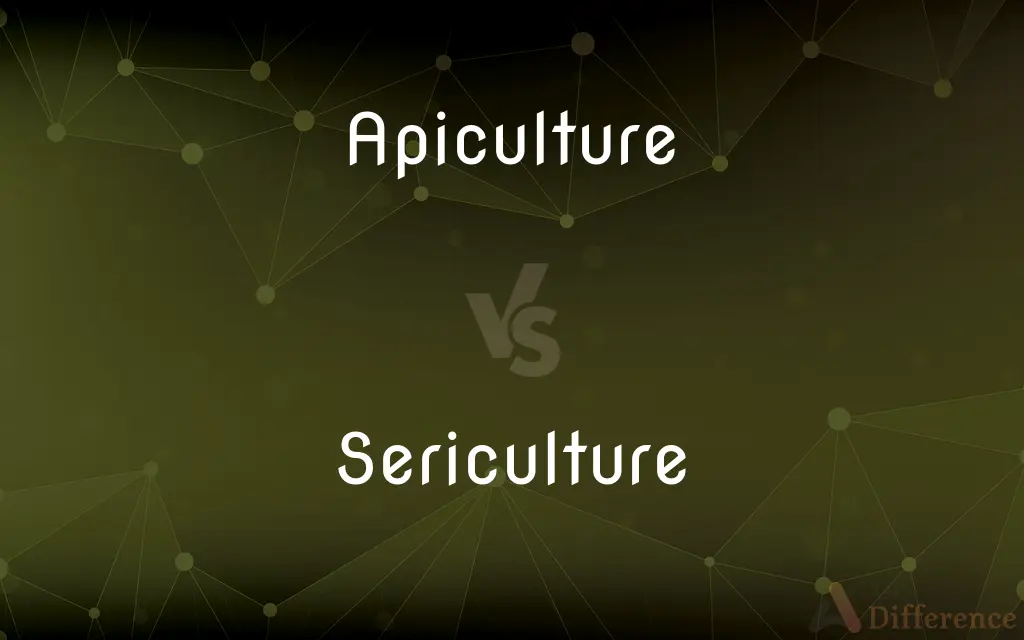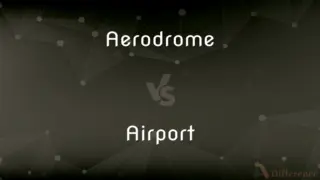Apiculture vs. Sericulture — What's the Difference?
By Tayyaba Rehman & Fiza Rafique — Updated on April 26, 2024
"Apiculture" refers to beekeeping, focusing on the maintenance of bee colonies, primarily for honey production, while "sericulture" involves the cultivation of silkworms for silk production.

Difference Between Apiculture and Sericulture
Table of Contents
ADVERTISEMENT
Key Differences
"Apiculture" centers on the practice of beekeeping, which includes caring for bees and harvesting their products such as honey and beeswax, whereas "sericulture" is the rearing of silkworms to obtain silk, emphasizing the lifecycle management of silkworms.
In apiculture, beekeepers manage hives and work to ensure the health and productivity of their bees, focusing on aspects like hive maintenance and disease prevention, while in sericulture, practitioners focus on feeding silkworms with mulberry leaves and maintaining optimal conditions for their growth and cocoon production.
The products of apiculture, such as honey and beeswax, are widely used in food, cosmetics, and medicines, whereas sericulture primarily produces silk, which is used in the textile industry for making garments and upholstery.
Apiculture contributes to biodiversity and plays a crucial role in the pollination of crops and wild plants, thereby supporting wider ecosystem health, whereas sericulture, though more niche, supports the economy through the luxury goods market and traditional textile crafts.
Environmental impacts differ as well; apiculture can be sustainable and beneficial for ecosystems when practiced responsibly, whereas sericulture requires significant resources for cultivation and processing, though it can also be managed sustainably under the right conditions.
ADVERTISEMENT
Comparison Chart
Definition
The practice of beekeeping
The cultivation of silkworms for silk production
Primary Products
Honey, beeswax, royal jelly
Silk
Purpose
Produce bee products, pollination
Produce silk for textiles
Environmental Impact
Generally beneficial for ecosystems
Resource-intensive, but can be sustainable
Key Practices
Hive management, disease control
Mulberry cultivation, cocoon harvesting
Compare with Definitions
Apiculture
The practice of maintaining bee colonies.
He took up apiculture to produce organic honey.
Sericulture
Primarily aimed at textile production.
The silk produced through sericulture was used in designing luxury gowns.
Apiculture
Contributes to natural pollination.
Her interest in apiculture stems from a desire to aid crop pollination.
Sericulture
Focuses on feeding silkworms mulberry leaves.
Their sericulture farm is next to a large mulberry plantation.
Apiculture
Involves harvesting products like honey and wax.
Apiculture has provided him with a steady supply of beeswax.
Sericulture
Can be resource-intensive but also sustainable.
They implemented new methods to make their sericulture more sustainable.
Apiculture
Concerned with the health and productivity of bees.
Effective apiculture requires understanding bee behavior.
Sericulture
Involves the extraction of silk from cocoons.
The process of silk extraction in sericulture is delicate and labor-intensive.
Apiculture
Sustainable practice with ecological benefits.
Apiculture supports local biodiversity through natural bee activities.
Sericulture
The rearing of silkworms for silk production.
Sericulture has been a family business for generations.
Apiculture
The raising and care of bees for commercial or agricultural purposes.
Sericulture
Sericulture, or silk farming, is the cultivation of silkworms to produce silk. Although there are several commercial species of silkworms, Bombyx mori (the caterpillar of the domestic silkmoth) is the most widely used and intensively studied silkworm.
Apiculture
The keeping and maintenance of bees for commercial reasons.
Sericulture
(agriculture) The rearing of silkworms for the production of silk.
Apiculture
Rearing of bees for their honey and wax.
Sericulture
The raising of silkworms.
Apiculture
The cultivation of bees on a commercial scale for the production of honey
Sericulture
Raising silkworms in order to obtain raw silk
Sericulture
The production of raw silk by raising silkworms
Common Curiosities
What are the environmental impacts of apiculture?
It is generally beneficial, aiding in pollination and biodiversity.
What is apiculture?
It is the practice of beekeeping, focused on managing bee colonies.
How do apiculture and sericulture differ in purpose?
Apiculture aims at honey production and pollination, whereas sericulture aims at producing silk.
Can apiculture and sericulture be practiced together?
Yes, they can complement each other in agricultural settings, but they require different skills and resources.
What is sericulture?
It involves the cultivation of silkworms specifically for the purpose of silk production.
What are the environmental impacts of sericulture?
It can be resource-intensive, though sustainable practices are increasingly adopted.
Which products come from sericulture?
The main product is silk, used in textiles.
What skills are needed for sericulture?
Knowledge of silkworm lifecycle management and optimal cultivation techniques.
What skills are needed for apiculture?
Knowledge of bee behavior, hive management, and disease prevention.
Which products come from apiculture?
Honey, beeswax, and royal jelly are primary products.
Share Your Discovery

Previous Comparison
Briefing vs. Debriefing
Next Comparison
Aerodrome vs. AirportAuthor Spotlight
Written by
Tayyaba RehmanTayyaba Rehman is a distinguished writer, currently serving as a primary contributor to askdifference.com. As a researcher in semantics and etymology, Tayyaba's passion for the complexity of languages and their distinctions has found a perfect home on the platform. Tayyaba delves into the intricacies of language, distinguishing between commonly confused words and phrases, thereby providing clarity for readers worldwide.
Co-written by
Fiza RafiqueFiza Rafique is a skilled content writer at AskDifference.com, where she meticulously refines and enhances written pieces. Drawing from her vast editorial expertise, Fiza ensures clarity, accuracy, and precision in every article. Passionate about language, she continually seeks to elevate the quality of content for readers worldwide.














































